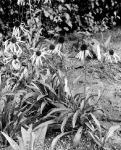 SYNONYM—Brauneria angustifolia DC. Heller
SYNONYM—Brauneria angustifolia DC. Heller
OTHER COMMON NAMES—Pale-purple coneflower, Sampson-root, niggerhead (in Kansas.)
HABITAT AND RANGE—Echinacea is found in scattered patches in rich prairie soil or sandy soil from Alabama to Texas and northwestward, being most abundant in Kansas and Nebraska. Tho not growing wild in the Eastern States, it has succeeded well under cultivation in the testing gardens of the Department of Agriculture at Washington, D. C.
DESCRIPTION OF PLANT—This native herbaceous perennial, belonging to the aster family (Asteraceae), grows to a height of from 2 to 3 feet. It sends up a rather stout bristly-hairy stem, bearing thick rough-hairy leaves, which are broadly lance shaped or linear lance shaped, entire, 3 to 8 inches long, narrowed at each end, and strongly three nerved. The lower leaves have slender stems, but as they approach the top of the plant the stems become shorter and some of the upper leaves are stemless.
The flower heads appearing from July to October, are very pretty, and the plant would do well as an ornamental in gardens. The flowers remain on the plant for a long time, and the color varies from whitish rose to pale purple. The head consists of ray flowers and disk flowers, the former constituting the "petals" surrounding the disk, and the disk itself being composed of small, tubular, greenish yellow flowers. When the flowers first appear the disk is flattened or really concave, but as the flowering progresses it becomes conical in shape. The brown fruiting heads are conical, chaffy, stiff and wiry.
DESCRIPTION OF ROOT—Echinacea has a thick, blackish root, which in commerce occurs in cylindrical pieces of varying length and thickness. The dried root is grayish brown on the outside, the bark wrinkled lengthwise and sometimes spirally twisted. It breaks with a short, weak fracture, showing yellow or greenish yellow wood edges, which give the impression that the wood is decayed.
The odor is scarcely perceptible and the taste is mildly aromatic, afterwards becoming acrid and inducing a flow of saliva.
COLLECTION, PRICES AND USES—The root of Echinacea is collected in autumn and brings from 20 to. 30 cents a pound. It is said that Echinacea varies greatly in quality due chiefly to the locality in which it grows. According to J. U. Lloyd, the best quality comes from the prairie lands of Nebraska and that from marshy places is inferior.
Echinacea is said to be an alterative and to promote perspiration and induce a flow of saliva. The Indians used the freshly scraped roots for the cure of snake bites.
Ginseng and Other Medicinal Plants, 1936, was written by A. R. Harding.

